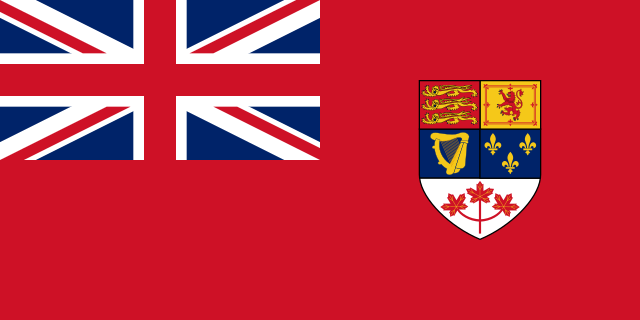Flag of Canada
national flag of Canada From Wikipedia, the free encyclopedia
The Maple Leaf flag became Canada's flag on 15 February 1965.
 | |
| Use | National flag |
|---|---|
| Proportion | 1:2 |
| Adopted | February 15, 1965 |
Before this, Canada used the British Red Ensign with Canada's coat of arms on it. Flag experts say that the Red Ensign was defaced by the coat of arms.
Flag and heraldry experts also call the design of the flag a Canadian Pale. This is because the white stripe in the middle (called a pale in heraldry) was not the usual narrow stripe but was half the width of the flag. This was the first time a design like this was used.
On some days the Canadian government flies the Royal Union Flag next to the Maple Leaf Flag. The Royal Union Flag is the British Union Jack, and is a symbol that Canada is a member of the Commonwealth, and that Canada and Britain share a history and a monarch.
The Queen of Great Britain, had some say in what the flag was to be. She thought that the maple leaf greatly represents the country of Canada.
Design and symbolism
The meaning of the colors of the national flag are as follows:
| Name | Color | HEX Code | Symbol |
|---|---|---|---|
| White | #FFFFFF | ||
| Red | #C90016 | ||
Canadian flag is called by heraldry experts as the flag with Canadian pale design. This is because the white stripe in the middle was not the usual narrow stripe but was half the width of the flag between two minor stripes.



History
Shortly after Canadian Confederation in 1867, the need for distinctive Canadian flags emerged. The first Canadian flag was that then used as the flag of the governor general of Canada, a Union Flag with a shield in the centre bearing the quartered arms of Ontario, Quebec, Nova Scotia and New Brunswick, surrounded by a wreath of maple leaves.[1] In 1870, the Red Ensign, with the addition of the Canadian composite shield in the fly, began to be used unofficially on land and sea[2] and was known as the Canadian Red Ensign. As new provinces joined the Confederation, their arms were added to the shield. In 1892, the British admiralty approved the use of the Red Ensign for Canadian use at sea.[2]
The composite shield was replaced with the coat of arms of Canada upon its grant in 1921 and, in 1924, an Order in Council approved its use for Canadian government buildings abroad.[3] In 1925, Prime Minister William Lyon Mackenzie King established a committee to design a flag to be used at home, but it was dissolved before the final report could be delivered. Despite the failure of the committee to solve the issue, public sentiment in the 1920s was in favour of fixing the flag problem for Canada.[4] New designs were proposed in 1927,[5] 1931,[6] and 1939.[7]
Related pages
References
Other websites
Wikiwand - on
Seamless Wikipedia browsing. On steroids.
